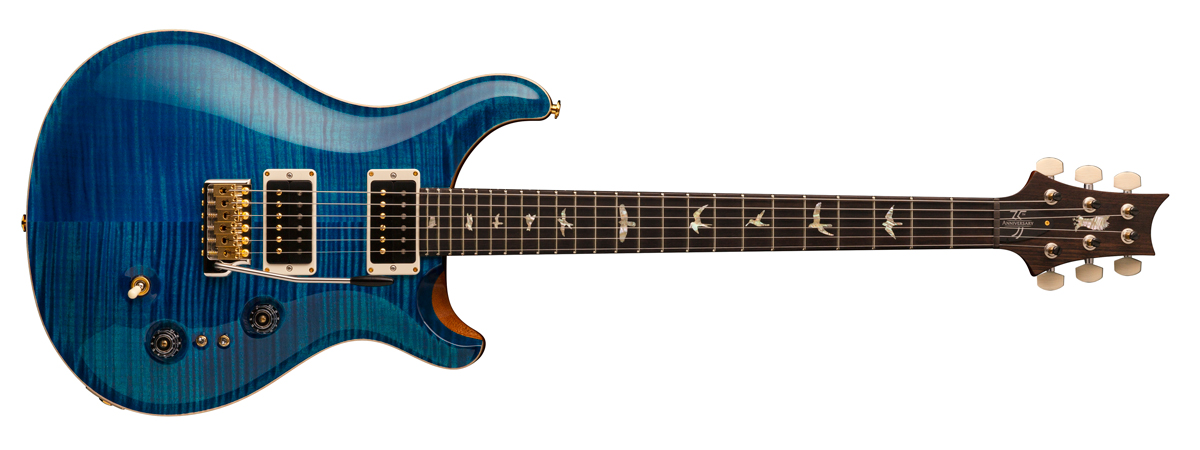It was the era of the Superstrat, but along came an all-new high-end guitar that found fans in Al Di Meola and Ted Nugent – celebrating 40 years of Paul Reed Smith’s first production model, the PRS Custom 24
Birthed amid the Superstrat mania of the 1980s, the Custom 24 bucked the trend with a set-neck build – and hit a spot with players that wanted timeless looks and modern, high performing upgrades

Very few classic guitar guitar models have remained in continuous production for 40 years since their initial introduction. Gibson’s Les Paul Model/Standard lasted only eight years from 1952-60 before its original design was temporarily discontinued and later revived in 1968, and even the venerated Stratocaster narrowly escaped the chopping block in the early Eighties during the final days of Fender’s CBS ownership.
The PRS Custom 24 (originally just called the Custom) has recently joined this rare class of long-lived classic instruments by celebrating its 40th anniversary. Introduced in 1985, the Custom was Paul Reed Smith’s first production model, and it made an immediate impressive first impression, thanks to its deft combination of skilled craftsmanship, high-quality materials and blend of classic features with modern upgrades.
Making its initial bow during the height of superstrat mania, the Custom provided an attractive alternative for guitarists who yearned for the high-quality standards, tones and classic looks of a vintage instrument but with modern, high-performance upgrades.
Key Custom 24 features include a 25-inch scale length that provides a “just right” balance between the slinky feel of a 24-3/4-inch Gibson-style scale and the twangy percussive attack of a 25-1/2-inch Fender-style scale, 24 frets and the super dependable non-locking PRS Tremolo System with a low-friction nut that keeps the strings reliably in tune.
The original pickups Standard Treble and Standard Bass humbuckers were Smith’s own design, and controls initially consisted of a master volume, five-position rotary pickup selector switch with humbucking and split coil settings and an innovative “sweet” switch that imitated a long cable’s capacitance load effect on treble frequencies.
The materials used for the highly figured flame-maple tops and one-piece mahogany backs come from Paul Reed Smith’s impressive stash of quality tone woods. PRS collectors seek Custom 24 models made before 1991, when the necks featured Brazilian rosewood fretboards. Early examples with “Birds” inlays also command a premium over models with round “Moon” inlays.

Paul Reed Smith constantly improved and refined the Custom 24’s design, including various design tweaks to the tremolo system, tuners and the introduction of evolving pickup designs.
All the latest guitar news, interviews, lessons, reviews, deals and more, direct to your inbox!
One of the biggest changes came in 2011, when the controls were changed to a master volume, master tone and five-position blade switch configuration. In the early Nineties PRS started offering a stop-tail bridge option, and today, players can choose variations of the Custom 24 with Floyd Rose or piezo bridges.

The list of Custom 24 users is long and spans a wide variety of musical styles. Ted Nugent and Al Di Meola were some of the Custom 24’s earliest adopters.
The model enjoyed a huge boost in popularity during the Nineties and early 2000s via players like Mikael Akerfeldt with Opeth, Mike Einziger with Incubus and Mike Shinoda and Brad Delson with Linkin Park. More recent fans include Adam Nolly Getgood and Mark Holcomb of Periphery and Ryan Knight of the Black Dahlia Murder.
- This article first appeared in Guitar World. Subscribe and save.
Chris is the co-author of Eruption - Conversations with Eddie Van Halen. He is a 40-year music industry veteran who started at Boardwalk Entertainment (Joan Jett, Night Ranger) and Roland US before becoming a guitar journalist in 1991. He has interviewed more than 600 artists, written more than 1,400 product reviews and contributed to Jeff Beck’s Beck 01: Hot Rods and Rock & Roll and Eric Clapton’s Six String Stories.
You must confirm your public display name before commenting
Please logout and then login again, you will then be prompted to enter your display name.


